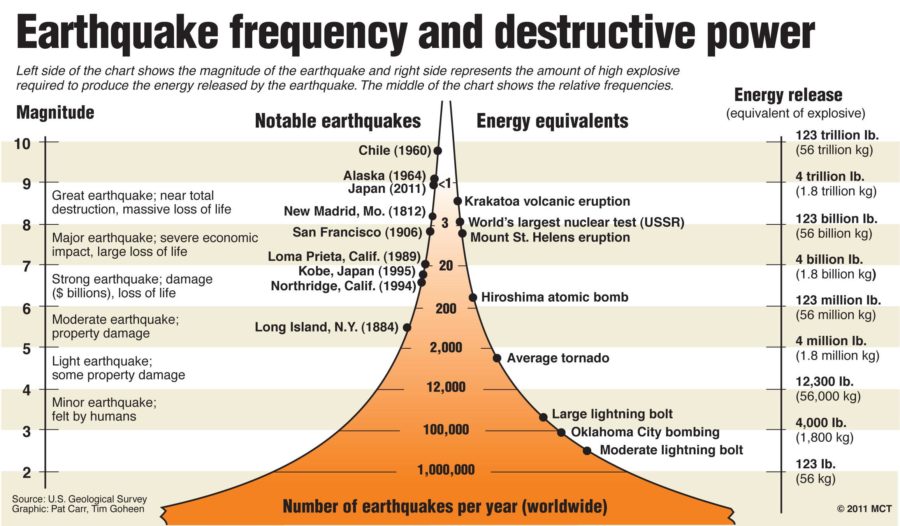Quakes shake the region
Graphic compares earthquake frequency, size, and destructive force
December 18, 2013
When many students think of earthquakes, they think of California, not Texas. However, a number of earthquakes in the region has increased significantly over the past few years, with several of these quakes occurring not far from the immediate community.
“We’ve been looking at the question of whether the number of earthquakes occurring across the mid-continent has changed in recent years,” U.S. Geological Survey geophysicist Bill Ellsworth said to StateImpact Texas. “We find that there is a statistically significant increase in the rate [of earthquakes in North Texas] just over the past several years.”
Last month, approximately 20 earthquakes rocked North Texas, with five of them originating in Azle. Some experts have been pointing at the natural gas drilling occurring in the Barnett Shale, a massive geological formation spanning across 20 North Texas counties, as the source of the abnormal tremors.
“They say it ain’t what happens, but ‘till then, we didn’t have it,” Fred Raub, a born-and-raised Azle resident, said to KERA news. “You’ve got a drill about every mile. You just start looking around at the drills they’re putting down.”
Between 1970 and 2007, the area around the town of Azle experienced just two earthquakes. However, since 2008, 74 tremors have been reported in the region.
“I’d say it certainly looks very possible that the earthquakes are related to [fluid] injection wells,” University of Texas at Austin earthquake researcher Cliff Frolich said to KHOU television.
Officials have been conducting daily inspections of the water reservoir dams in North Texas, such as Eagle Mountain Lake in Fort Worth, to check for cracked foundations that could cause destructive flooding.
Don Blakeman, a geophysicist with the National Earthquake Information Center, says
that while the quakes could possibly be the result of oil and gas production, there could be other explanations, such as a natural swarm, a series of small earthquakes, that occurs naturally.
“Obviously, if this is oil and gas production related, they might continue until that activity stops,” Blakeman said to KERA news. “The other possibility is that it’s just a natural swarm, because we do see that sort of thing occurring sometimes in areas where we haven’t had quakes before.”
One of the strongest earthquakes in Texas history occurred in September, when a 4.1 magnitude tremor rattled the east Texas town of Timpson, located about 25 miles northeast of Nacogdoches. The Timpson earthquake, however, did not break the record of the strongest earthquake to strike Texas – that honor goes to a 5.1 magnitude quake that struck the town of Valentine in 1931.
With earthquakes appearing to increase in frequency and strength, Blakeman advises residents to be prepared if a more destructive quake occurs in the near future.
“Find out what kind of preparations they can do,” Blakeman said. “Take things off
high shelves, know where to stand if an earthquake is to occur, to be safer in their house.”
While the quakes have been appearing to increase, there is a probability that these abnormal events will eventually slow down.
“The good news is that based on what typically happens, they’ll die down in a while,” Blakeman said. “You can’t predict one way or the other with absolute certainty.”



